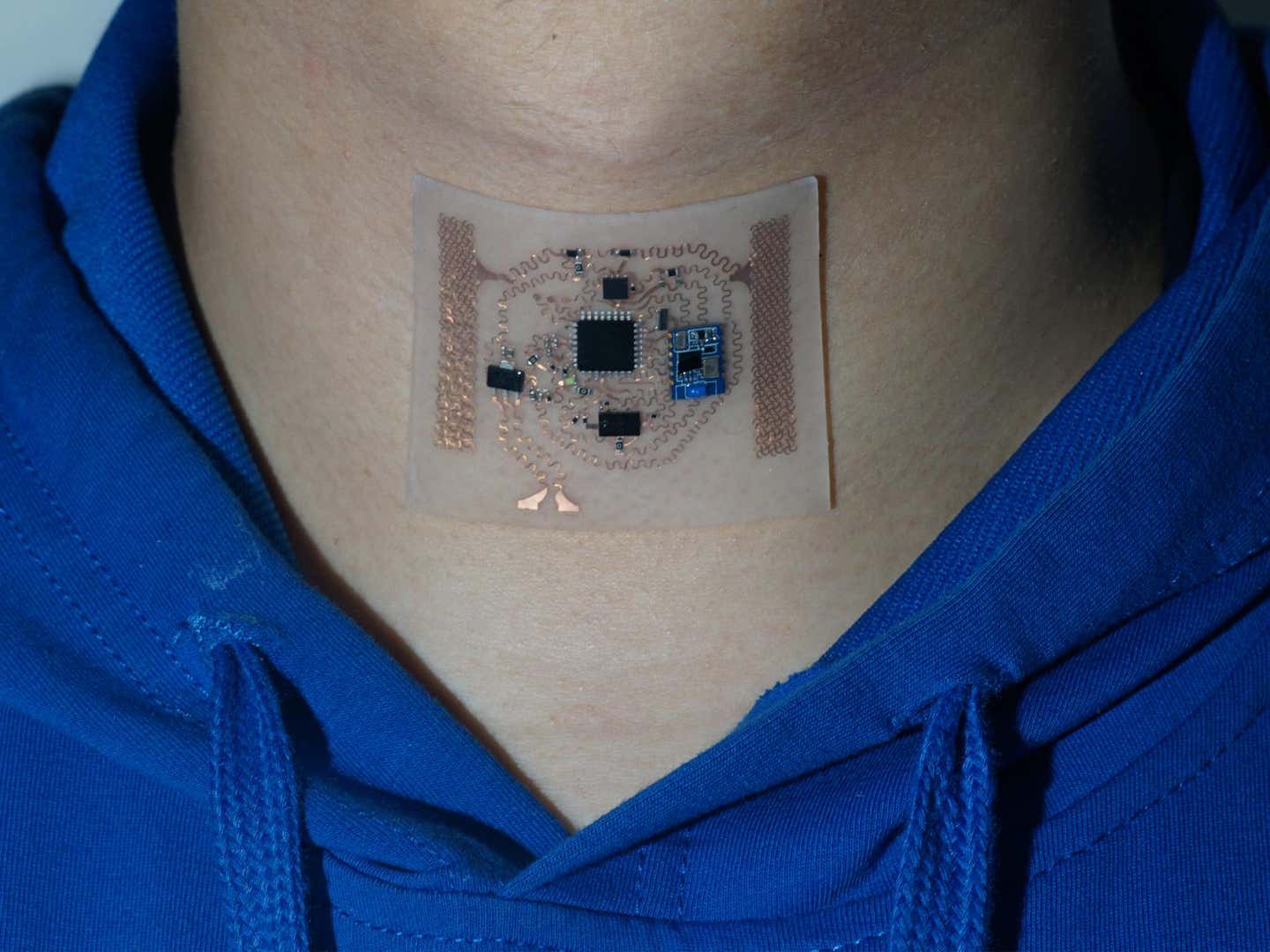Stretchy, wearable, throat sensor revolutionizes remote health monitoring
Researchers have unveiled an innovative solution that promises to revolutionize remote health monitoring and medical treatment

[Jan. 11, 2024: JD Shavit, The Brighter Side of News]
Engineering researchers created a new stretchy, wearable throat sensor that records vibrations and electrical muscle impulses from the neck area to monitor a user’s speech and swallowing patterns. (CREDIT: Huanyu Cheng)
In the rapidly evolving landscape of healthcare technology, researchers have unveiled an innovative solution that promises to revolutionize remote health monitoring and the evaluation of medical treatments.
The development, showcased in a recent study published in Nature Communications, centers around a sophisticated machine learning platform designed to efficiently analyze and predict data collected by wearable medical sensors.
This groundbreaking platform has been applied to a novel stretchy throat sensor, capable of monitoring speech and swallowing patterns by recording vibrations and electrical muscle impulses in the neck area.
Lead researcher Huanyu "Larry" Cheng, the James L. Henderson, Jr. Memorial Associate Professor of Engineering Science and Mechanics at Penn State, emphasized the pressing need for soft and flexible on-throat devices in the healthcare market.
Related Stories:
These devices, Cheng explained, are essential for the continuous monitoring of muscle and swallowing movements in patients with throat-related conditions, enabling accurate diagnoses and tailored treatments. Current devices, on the other hand, fall short in providing comprehensive health insights, often being bulky and uncomfortable.
The key component of this groundbreaking wearable is its composite hydrogel electrode interface. Cheng pointed out that this interface has been meticulously engineered to withstand the natural movements of the user's skin surface while ensuring high-quality signal transmission. This flexible and easily applicable insoluble hydrogel material serves as the perfect conduit for the embedded sensors.
Cheng explained, "The hydrogel can directly interface with the skin and provides a conductive property for the sensors." This innovative hydrogel sensor collects valuable data on vibrations and muscle movements, which are then fed into a sophisticated machine learning algorithm for in-depth analysis. Subsequently, the data is transmitted to a custom-built cloud interface, enabling healthcare providers to remotely access and evaluate patient information.
Overview and design of the standalone stretchable laryngeal patch. (CREDIT: Nature Communications)
Libo Gao, co-principal investigator and associate professor at the Pen-Tung Sah Institute of Micro-Nano Science and Technology at Xiamen University in China, delved into the intricacies of data collection and processing.
"The patient data is collected by the patch at different frequencies, depending on the statistic type, such as swallowing, speaking, or respiration," Gao explained. "The algorithm groups the four frequencies into one streamlined output, which makes the data much more useful for healthcare providers to quickly look at and judge."
Block functional diagram showing the processing steps of the acceleration and surface electromyography (sEMG) signals, including signal processing, controlling, communication, and display. Schematic showing the use of a machine learning network and the standalone stretchable patch in laryngeal post-surgical rehabilitation. (CREDIT: Nature Communications)
One of the standout features of this machine learning algorithm is its adaptability and memory functions. Gao revealed that after merely one minute of collecting throat movement data and undergoing three hours of offline training, the algorithm can predict patient data with astounding accuracy exceeding 90%. This capability empowers clinicians to make more informed diagnoses promptly and even foresee the potential outcomes of different treatment regimens.
Cheng expanded on the broader implications of this technology, stating, "Adaptive machine learning could also help account for the individual differences in data among a large population, so that researchers can make inferences on the health of a large population based on individual datasets." This groundbreaking platform not only enhances the precision of medical diagnoses but also has the potential to advance population-wide health research by harnessing the power of individualized data.
Electronical and mechanical characterizations of the patch. Optical images of the patch on the forearm under rest, watering, pinching, stretching, compressing, and twisting conditions (no external adhesive). (CREDIT: Nature Communications)
With the ability to monitor speech and swallowing patterns in real-time, remotely analyze data, and provide predictive insights with remarkable accuracy, this innovative technology promises to transform the landscape of healthcare, empowering clinicians to deliver more personalized care and advance our understanding of population health.
As we move into an era of unprecedented innovation, the intersection of wearable technology and advanced machine learning holds the promise of a healthier future for all.
Note: Materials provided above by the The Brighter Side of News. Content may be edited for style and length.
Like these kind of feel good stories? Get the Brighter Side of News' newsletter.
Joshua Shavit
Science & Technology Writer | AI and Robotics Reporter
Joshua Shavit is a Los Angeles-based science and technology writer with a passion for exploring the breakthroughs shaping the future. As a contributor to The Brighter Side of News, he focuses on positive and transformative advancements in AI, technology, physics, engineering, robotics and space science. Joshua is currently working towards a Bachelor of Science in Business Administration at the University of California, Berkeley. He combines his academic background with a talent for storytelling, making complex scientific discoveries engaging and accessible. His work highlights the innovators behind the ideas, bringing readers closer to the people driving progress.



